Gaming Futures, LLC specializes in Windows application development/support, PlayStation2 development, Xbox development, 2D and 3D art and visual effects, and project guidance. Formed by veterans of Modicum On-Line and Axiomatic InterRational, Gaming Futures is committed to creating high-quality, innovative games and software. They offer game concepts and development for PC, PS2, Xbox, and Pocket PC, as well as game platform ports, 2D and 3D art and programming, interface design and software enhancement, and a cohesive development team with a proven track record. The company is formed from the core group of the last DreæmWhyrks project at Axiomatic and has a production team with four years of successful product development and over 30 years of combined experience. Gaming Futures has a documented history of completing projects under budget and on time. Currently, the company has secured contracts with Clear Mountain Productions and Weaver Farm, Inc.
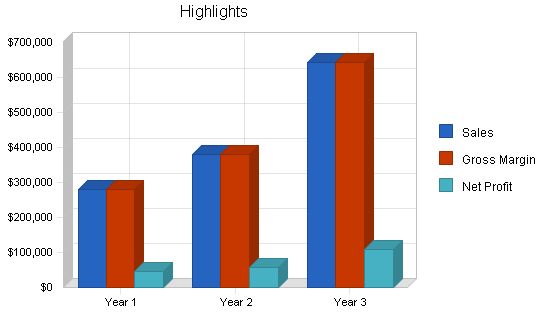
Gaming Futures has the following objectives:
– Achieve $200,000 sales goal in the first year.
– Establish a customer base of 40 companies.
– Increase sales by 15% in the second year.
The mission of Gaming Futures is to provide high-quality service by developing innovative and exciting products for the interactive entertainment industry.
Gaming Futures, LLC is a game development studio that offers Windows application development and support, PS2 development, Xbox development, 2D and 3D art, visual effects, and project guidance. The company will be organized as a Limited Liability Corporation.
Gaming Futures, LLC is owned by a team of developers:
– Bill Kerl
– Diane Huber
– Marcus Hathcock
– Jillian Daley
– Jeremy Lang
Gaming Futures is located in a 3,000 square foot office space in the Northwest Industrial Park in northwest Madison.
The start-up expenses for Gaming Futures primarily include equipment and office space. William, Diane, Marcus, Jillian, and Jeremy will each invest $35,000. Additionally, Gaming Futures will secure a $100,000 long-term loan.
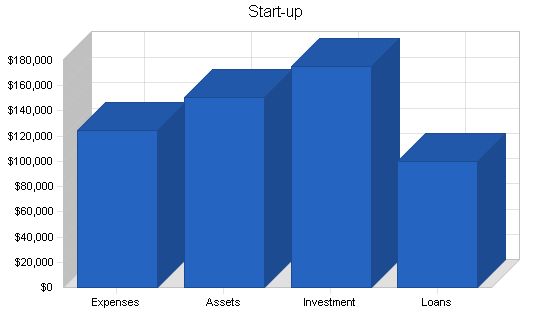
Start-up Funding
Start-up Expenses to Fund: $124,300
Start-up Assets to Fund: $150,700
Total Funding Required: $275,000
Assets
Non-cash Assets from Start-up: $90,000
Cash Requirements from Start-up: $60,700
Additional Cash Raised: $0
Cash Balance on Starting Date: $60,700
Total Assets: $150,700
Liabilities and Capital
Liabilities
Current Borrowing: $0
Long-term Liabilities: $100,000
Accounts Payable (Outstanding Bills): $0
Other Current Liabilities (interest-free): $0
Total Liabilities: $100,000
Capital
Planned Investment
Bill Kerl: $35,000
Diane Huber: $35,000
Marcus Hathcock: $35,000
Jillian Daley: $35,000
Jeremy Lang: $35,000
Additional Investment Requirement: $0
Total Planned Investment: $175,000
Loss at Start-up (Start-up Expenses): ($124,300)
Total Capital: $50,700
Total Capital and Liabilities: $150,700
Total Funding: $275,000
Start-up
Requirements
Start-up Expenses
Legal: $1,000
Stationery etc.: $400
Brochures: $400
Insurance: $1,000
Rent: $1,500
Expensed Equipment: $120,000
Total Start-up Expenses: $124,300
Start-up Assets
Cash Required: $60,700
Other Current Assets: $20,000
Long-term Assets: $70,000
Total Assets: $150,700
Total Requirements: $275,000
Services
Gaming Futures’ cohesive, talented development team offers clients:
– Game concepts and development for PC, PS2, Xbox, Pocket PC
– Game platform ports: PC/PS2/Xbox/Game Boy
– 2D and 3D art, programming, libraries to spec.
– Interface design and software enhancement.
– On time and on budget shipping.
Market Analysis Summary
A new report from DFC Intelligence forecasts a 40% growth in annual unit sales of video games and PC games in the U.S. from 2001 to 2006. The successful introduction of new game systems in 2000 and 2001 has contributed to this growth. The interactive games industry is a major economic force, rivaling Hollywood in revenues and accounting for nearly one-third of consumer software sales in North America.
4.1 Target Market Segment Strategy
The video game market in the U.S. grew from $6.6 billion in 2000 to $9.4 billion in 2001. Sales of the three leading game systems are projected to reach over 60 million units by 2006. However, the industry faces challenges, as development and marketing costs continue to rise.
4.2 Service Business Analysis
Companies are outsourcing segments of the development project to combat rising costs. This strategy allows them to access gaming expertise without the personnel expenses. By outsourcing key elements of the development process, companies can save up to 30% of development costs.
4.2.1 Competition and Buying Patterns
The interactive game industry outsources to companies with a track record of meeting deadlines and producing high-quality products. Companies specialize in gaming devices or target users to gain an advantage in the outsourcing process.
Strategy and Implementation Summary
Gaming Futures’ competitive edge lies in delivering projects before the deadline. This is crucial for outsourced projects, as meeting deadlines increases the likelihood of receiving more work. William Kerl and Diane Huber, the company’s developers, will be responsible for marketing the company’s services.
Gaming Futures will approach 120 production companies with a marketing CD. The team has already acquired contracts with Clear Mountain Productions and Weaver Farm, Inc., and will continue to aggressively pursue new contracts.
5.3 Sales Strategy
Sales are expected to start during the third month of operation. The first two months will have flat sales, but after that, sales will increase.
5.3.1 Sales Forecast
The following sales forecast covers three years. During the first three months, all five owners will be involved in sales, and they have agreed not to take a salary during this phase.
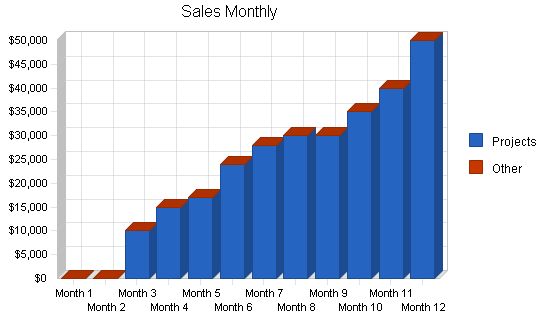
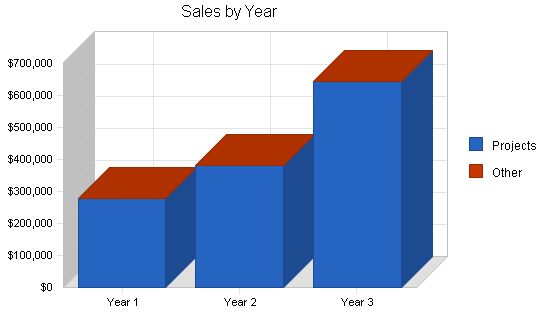
Sales Forecast
Year 1 Year 2 Year 3
Sales
Projects $279,000 $380,000 $644,000
Other $0 $0 $0
Total Sales $279,000 $380,000 $644,000
Direct Cost of Sales
Year 1 Year 2 Year 3
Projects $0 $0 $0
Other $0 $0 $0
Subtotal Direct Cost of Sales $0 $0 $0
5.4 Milestones
The table lists program milestones, dates, managers in charge, and budgets. The milestone schedule emphasizes planning for implementation.
The commitment behind the table is not shown. Our business plan includes provisions for plan-vs.-actual analysis, and we will hold monthly follow-up meetings to discuss variance and course corrections.
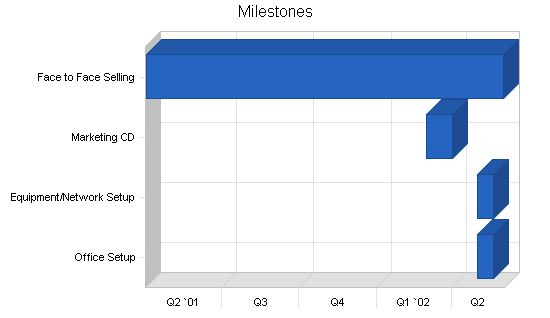
Milestones:
– Office Setup: 5/1/2002 – 5/20/2002, $5,000 budget, Manager: William Kerl, Department: Admin
– Equipment/Network Setup: 5/1/2002 – 5/20/2002, $100,000 budget, Manager: Jeremy Lang, Department: Admin
– Marketing CD: 3/1/2002 – 4/1/2002, $2,000 budget, Manager: Diane Huber, Department: Web
– Face to Face Selling: 4/1/2001 – 6/1/2002, $2,000 budget, Manager: All, Department: Web
– Totals: $109,000 budget
Personnel Plan:
– Bill Kerl – Producer/New Business: Started with games in 1993 programming on the 3DO, then programming and producing DreæmWhyrks games since 1995.
– Diane Huber – Lead Engineer: Programming computers for over 25 years and making great games for the last 15 years.
– Marcus Hathcock – Programmer/GamePlay: Software engineer with 5 years experience implementing interfaces and gameplay.
– Jillian Daley – Senior Software Engineer: 11 years programming experience building games, tools, and technologies.
– Jeremy Lang – Software Engineer: Specializes in using artificial intelligence to simulate physical events. Projects include DreæmWhyrks series, Mighty Quinn, Fire Mountain, and Storm Warnings.
– President: No salary in year 1 and year 2, $120,000 salary in year 3.
– Total People: 5 in year 1 and year 2, 6 in year 3.
– Total Payroll: $135,000 in year 1, $210,000 in year 2, $370,000 in year 3.
Management Team Gaps:
– The firm currently lacks a corporate leader to manage the anticipated growth of the company during its third year and beyond. This critical vacancy will be addressed by hiring a President.
Financial Plan:
– Break-even Analysis: Table and chart displaying our Break-even Analysis.
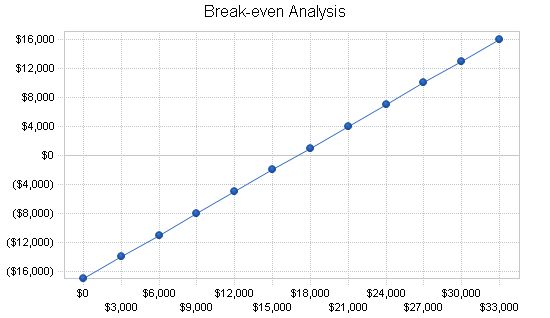
Break-even Analysis:
Monthly Revenue Break-even: $16,971
Assumptions:
– Average Percent Variable Cost: 0%
– Estimated Monthly Fixed Cost: $16,971
7.2 Projected Profit and Loss:
The table and charts below display the projected profit and loss for three years.
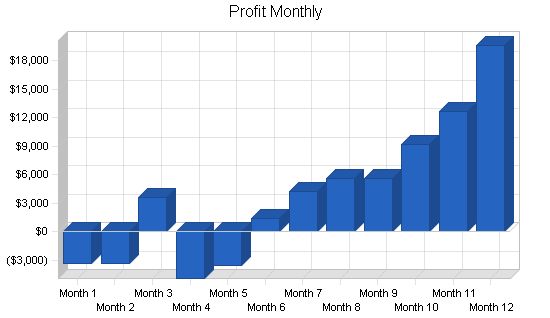
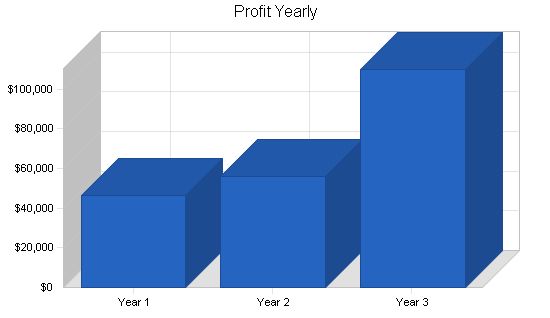

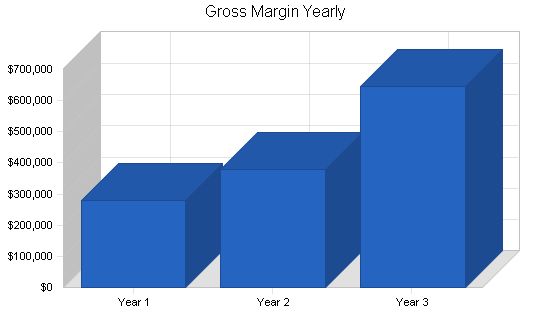
Pro Forma Profit and Loss
Year 1 Year 2 Year 3
Sales $279,000 $380,000 $644,000
Direct Cost of Sales $0 $0 $0
Other Production Expenses $0 $0 $0
Total Cost of Sales $0 $0 $0
Gross Margin $279,000 $380,000 $644,000
Gross Margin % 100.00% 100.00% 100.00%
Expenses
Payroll $135,000 $210,000 $370,000
Sales and Marketing and Other Expenses $12,000 $15,000 $20,000
Depreciation $9,996 $10,000 $10,000
Leased Equipment $0 $0 $0
Utilities $4,800 $4,800 $4,800
Insurance $3,600 $3,600 $3,600
Rent $18,000 $18,000 $18,000
Payroll Taxes $20,250 $31,500 $55,500
Other $0 $0 $0
Total Operating Expenses $203,646 $292,900 $481,900
Profit Before Interest and Taxes $75,354 $87,100 $162,100
EBITDA $85,350 $97,100 $172,100
Interest Expense $8,960 $7,080 $5,080
Taxes Incurred $19,918 $24,006 $47,106
Net Profit $46,476 $56,014 $109,914
Net Profit/Sales 16.66% 14.74% 17.07%
7.3 Projected Cash Flow
The table and chart below show the projected cash flow for three years.
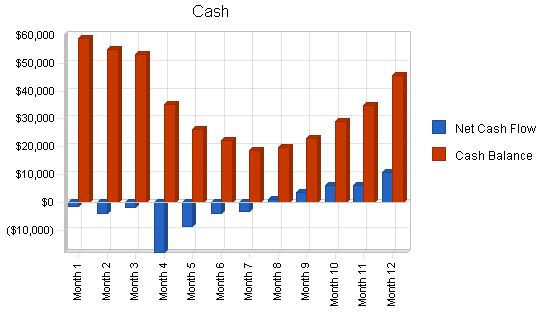
Pro Forma Cash Flow
| Cash Flow | |||
| Year 1 | Year 2 | Year 3 | |
| Cash Received | |||
| Cash from Operations | |||
| Cash Sales | $69,750 | $95,000 | $161,000 |
| Cash from Receivables | $142,750 | $260,927 | $420,075 |
| Subtotal Cash from Operations | $212,500 | $355,927 | $581,075 |
| Additional Cash Received | |||
| Sales Tax, VAT, HST/GST Received | $0 | $0 | $0 |
| New Current Borrowing | $0 | $0 | $0 |
| New Other Liabilities (interest-free) | $0 | $0 | $0 |
| New Long-term Liabilities | $0 | $0 | $0 |
| Sales of Other Current Assets | $0 | $0 | $0 |
| Sales of Long-term Assets | $0 | $0 | $0 |
| New Investment Received | $0 | $0 | $0 |
| Subtotal Cash Received | $212,500 | $355,927 | $581,075 |
| Expenditures | Year 1 | Year 2 | Year 3 |
| Expenditures from Operations | |||
| Cash Spending | $135,000 | $210,000 | $370,000 |
| Bill Payments | $73,476 | $109,491 | $149,968 |
| Subtotal Spent on Operations | $208,476 | $319,491 | $519,968 |
| Additional Cash Spent | |||
| Sales Tax, VAT, HST/GST Paid Out | $0 | $0 | $0 |
| Principal Repayment of Current Borrowing | $0 | $0 | $0 |
| Other Liabilities Principal Repayment | $0 | $0 | $0 |
| Long-term Liabilities Principal Repayment | $19,200 | $20,000 | $20,000 |
| Purchase Other Current Assets | $0 | $0 | $0 |
| Purchase Long-term Assets | $0 | $0 | $0 |
| Dividends | $0 | $0 | $0 |
| Subtotal Cash Spent | $227,676 | $339,491 | $539,968 |
| Net Cash Flow | ($15,176) | $16,435 | $41,107 |
| Cash Balance | $45,524 | $61,959 | $103,066 |
7.4 Projected Balance Sheet
The following table highlights the projected balance sheet for three years.
| Balance Sheet | |||
| Year 1 | Year 2 | Year 3 | |
| Assets | |||
| Current Assets | |||
| Cash | $45,524 | $61,959 | $103,066 |
| Accounts Receivable | $66,500 | $90,573 | $153,498 |
| Other Current Assets | $20,000 | $20,000 | $20,000 |
| Total Current Assets | $132,024 | $172,533 | $276,564 |
| Long-term Assets | |||
| Long-term Assets | $70,000 | $70,000 | $70,000 |
| Accumulated Depreciation | $9,996 | $19,996 | $29,996 |
| Total Long-term Assets | $60,004 | $50,004 | $40,004 |
| Total Assets | $192,028 | $222,537 | $316,568 |
| Liabilities and Capital | Year 1 | Year 2 | Year 3 |
| Current Liabilities | |||
| Accounts Payable | $14,052 | $8,547 | $12,665 |
| Current Borrowing | $0 | $0 | $0 |
| Other Current Liabilities | $0 | $0 | $0 |
| Subtotal Current Liabilities | $14,052 | $8,547 | $12,665 |
| Long-term Liabilities | $80,800 | $60,800 | $40,800 |
| Total Liabilities | $94,852 | $69,347 | $53,465 |
| Paid-in Capital | $175,000 | $175,000 | $175,000 |
| Retained Earnings | ($124,300) | ($77,824) | ($21,810) |
| Earnings | $46,476 | $56,014 | $109,914 |
| Total Capital | $97,176 | $153,190 | $263,104 |
| Total Liabilities and Capital | $192,028 | $222,537 | $316,568 |
| Net Worth | $97,176 | $153,190 | $263,104 |
7.5 Business Ratios
Business ratios for the years of this plan are shown below. Industry profile ratios based on the Standard Industrial Classification (SIC) code 7371, Computer Programming Services, are shown for comparison.
| Ratio Analysis | ||||
| Year 1 | Year 2 | Year 3 | Industry Profile | |
| Sales Growth | 0.00% | 36.20% | 69.47% | 10.40% |
| Percent of Total Assets | ||||
| Accounts Receivable | 34.63% | 40.70% | 48.49% | 24.10% |
| Other Current Assets | 10.42% | 8.99% | 6.32% | 42.90% |
| Total Current Assets | 68.75% | 77.53% | 87.36% | 71.10% |
| Long-term Assets | 31.25% | 22.47% | 12.64% | 28.90% |
| Total Assets | 100.00% | 100.00% | 100.00% | 100.00% |
| Current Liabilities | 7.32% | 3.84% | 4.00% | 47.80% |
| Long-term Liabilities | 42.08% | 27.32% | 12.89% | 19.10% |
| Total Liabilities | 49.39% | 31.16% | 16.89% | 66.90% |
| Net Worth | 50.61% | 68.84% | 83.11% | 33.10% |
| Percent of Sales | ||||
| Sales | 100.00% | 100.00% | 100.00% | 100.00% |
| Gross Margin | 100.00% | 100.00% | 100.00% | 0.00% |
| Selling, General & Administrative Expenses | 83.34% | 85.26% | 82.93% | 82.10% |
| Advertising Expenses | 4.30% | 3.95% | 3.11% | 1.20% |
| Profit Before Interest and Taxes | 27.01% | 22.92% | 25.17% | 2.00% |
| Main Ratios | ||||
| Current | 9.40 | 20.19 | 21.84 | 1.30 |
| Quick | 9.40 | 20.19 | 21.84 | 1.03 |
| Total Debt to Total Assets | 49.39% | 31.16% | 16.89% | 66.90% |
| Pre-tax Return on Net Worth | 68.32% | 52.24% | 59.68% | 3.10% |
| Pre-tax Return on Assets | 34.58% | 35.96% | 49.60% | 9.30% |
| Additional Ratios | Year 1 | Year 2 | Year 3 | |
| Net Profit Margin | 16.66% | 14.74% | 17.07% | n.a |
| Return on Equity | 47.83% | 36.57% | 41.78% | n.a |
| Activity Ratios | ||||
| Accounts Receivable Turnover | 3.15 | 3.15 | 3.15 | |
Hello!
I’m Andrew Brooks, a seasoned finance consultant from the USA and the mind behind phonenumber247.com.
My career is built on a foundation of helping individuals and businesses thrive financially in an ever-changing economic landscape. At phonenumber247.com, my aim is to demystify the complex world of finance, providing clear, actionable advice that can help you navigate your financial journey with confidence. Whether it’s personal finance management, investment strategies, or understanding the nuances of market dynamics, I’m here to share insights and tools that can propel you towards your financial goals.
Welcome to my digital space, where every piece of advice is a step closer to financial clarity and success!
